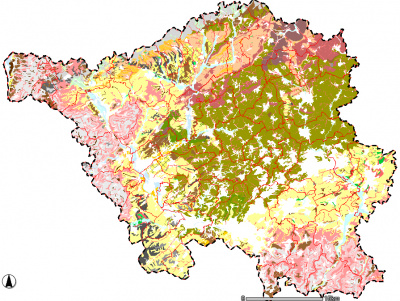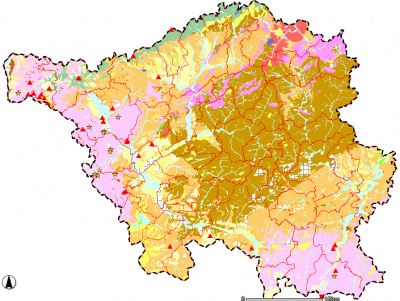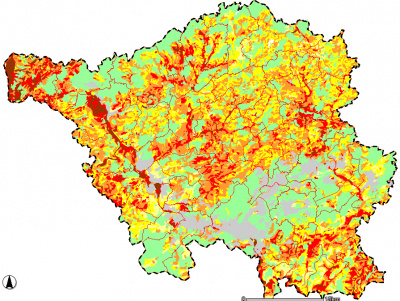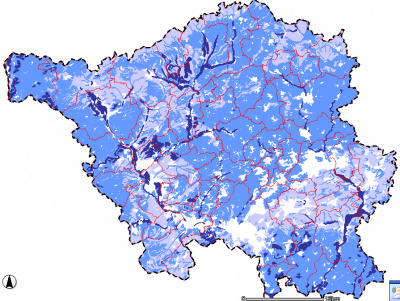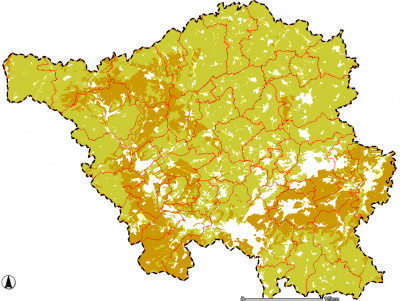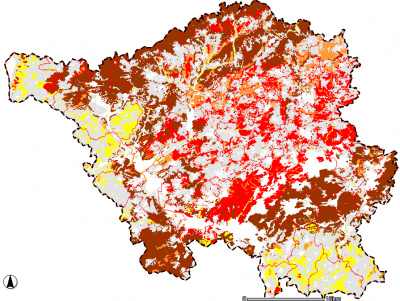Bodenschutz/en: Unterschied zwischen den Versionen
Tschug (Diskussion | Beiträge) |
Tschug (Diskussion | Beiträge) |
||
| Zeile 70: | Zeile 70: | ||
''(provides information about supply of oxygen to plant roots)'' |
''(provides information about supply of oxygen to plant roots)'' |
||
| − | <p>[[File:Luft.jpg|400px|alt= |
+ | <p>[[File:Luft.jpg|400px|alt=Map of soil air capacity|Map of soil air capacity|link=//{{SERVERNAME}}/mapbender/frames/index.php?lang=de&gui_id=Geoportal-SL-2020&WMC=3029]]</p> |
<p>Die Luftkapazität wird durch den Anteil der weiten Grobporen im Porenraum des Bodens bestimmt. Sie kennzeichnet die Versorgung der Pflanzenwurzeln mit Sauerstoff und die Durchlüftung der Böden. Zur Vergleichbarkeit der Ergebnisse erfolgt die Bewertung der Luftkapazität bis 10 dm Profiltiefe (LK10).</p> |
<p>Die Luftkapazität wird durch den Anteil der weiten Grobporen im Porenraum des Bodens bestimmt. Sie kennzeichnet die Versorgung der Pflanzenwurzeln mit Sauerstoff und die Durchlüftung der Böden. Zur Vergleichbarkeit der Ergebnisse erfolgt die Bewertung der Luftkapazität bis 10 dm Profiltiefe (LK10).</p> |
||
Version vom 18. März 2022, 13:19 Uhr
Soil conservation

Soil performs a wide range of functions for the environment and human society. At the same time, soil is a fragile and non-reproducible resource that is exposed to many stresses from usage. As a basis for preventive soil conservation, land surveys conducted by soil scientists collect regionalised data about soil distribution, its state of health and need for protection, and hazards threatening soil in Saarland. The online map service from the State Office of the Environment and Occupational Safety currently offers eight applications for soils across Saarland.
Soil survey map
(shows soil distribution)
The soil survey map uses a 1:100,000 scale (BÜK 100) to offer a regionalised presentation of the soil science inventory. For reasons of scale and also because of the closely-spaced substrate transitions in Saarland, the extant soil units are typically characterised as ‘soil clusters’. A detailed guide provides explanations of the ecological properties of these soils.
Go to application: ‘Soil survey map (BÜK 100)’
Quaternary map
(offers insights into the most recent geological period in Saarland)
The quaternary period has left its mark in Saarland both in the form of independent substrates such as loess sections or river terrace deposits as well as periglacial processes of formation that have affected the uppermost layers of the pre-quaternary bedrock.
Go to application: ‘Quaternary map’
Map of nitrate retention capacity
(charts the storage capacity in the vadose zone for nitric nitrogen)
The nitrate retention capacity of soils in Saarland has been determined on the basis of the soil survey map and physical soil data from the Saarland Soil Information System (SAARBIS). The 1:100,000 scale survey map is used to identify soils that have a higher level of risk exposure for nitrate discharges into groundwater.
Go to application: ‘Nitrate retention capacity’
Map of natural yield potential
(offers information about soil fertility)
The presentation of the natural yield potential for agrarian soils addresses one of the usage functions defined in the German Federal Soil Protection Law (BBodSchG), section 2(2) and characterises the capacity of the soil to produce food as well as energy crops.
Go to application: ‘Natural yield potential’
Map of soil field capacity
(characterises soil water retention capacity)
The 1:100,000 scale survey map presents a core parameter as utilised in soil water management. The term ‘field capacity’ refers to the quantity of water that a soil in a natural state can retain after gravitational drainage and is a metric for soil water retention capacity. To ensure results are comparable, field capacity is evaluated up to a profile depth of 10 dm (FK10).
Go to application: ‘Soil field capacity’
Map of soil air capacity
(provides information about supply of oxygen to plant roots)
Die Luftkapazität wird durch den Anteil der weiten Grobporen im Porenraum des Bodens bestimmt. Sie kennzeichnet die Versorgung der Pflanzenwurzeln mit Sauerstoff und die Durchlüftung der Böden. Zur Vergleichbarkeit der Ergebnisse erfolgt die Bewertung der Luftkapazität bis 10 dm Profiltiefe (LK10).
Zur Anwendung der Luftkapazität der Böden
Karte der Standorttypisierung und des Biotopentwicklungspotenzials der Böden
(Darstellung der vom Boden geprägten Lebensraumfunktionen für die Vegetation)
Für die Standorttypisierung der Böden des Saarlandes wurden die Bodeneinheiten der Bodenübersichtskarte des Saarlandes im Maßstab 1:100.000 zu 11 Standorttypen mit unterschiedlichem Feuchteregime und Stoffbeständen gruppiert. In Abhängigkeit von Wassergehalt und Nährstoffversorgung weisen die Standorttypen ein hohes bis sehr hohes Biotopentwicklungspotenzial auf.
Zur Anwendung "Standorttypisierung und des Biotopentwicklungspotenzials der Böden"
Karte der Pufferbereiche von Oberböden unter forstwirtschaftlicher Nutzung
(zeigt ein regionalisiertes Bild der Bodenversauerung)
Die Karte im Maßstab 1:100.000 bildet die Pufferbereiche von Böden und damit einen Indikator für das Ausmaß der Bodenversauerung ab. Die Datenbasis repräsentiert Untersuchungen bis zum Jahr 1995, so dass die Säureeinträge von fast zwei Dekaden unberücksichtigt bleiben. Aktuelle Daten liegen für gebietsbezogenen Studien vor und sind zu einem späteren Zeitpunkt verfügbar.
Zur Anwendung "Pufferbereiche von Oberböden unter forstwirtschaftlicher Nutzung"
Ansprechpartner
Ministerium für Umwelt und Verbraucherschutz
Landesamt für Umwelt- und Arbeitsschutz "Schutzgebiete und Boden"
Katja Drescher-Larres
E-Mail Kontakt
Telefon: +49 681 8500-1160
